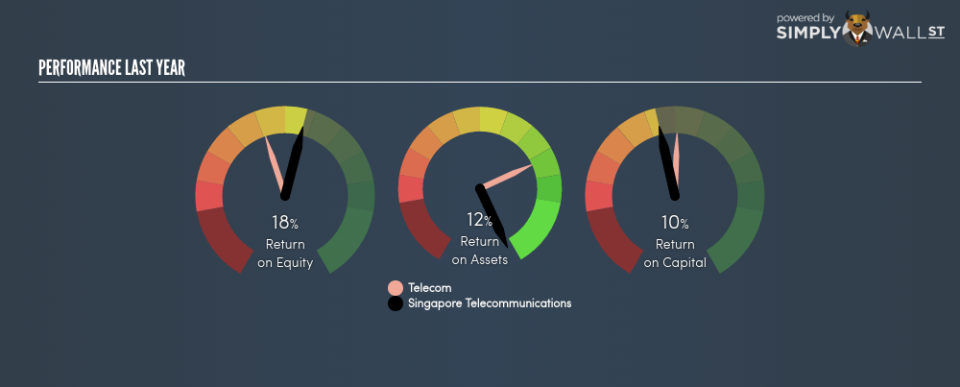Did Singapore Telecommunications Limited (SGX:Z74) Create Value For Shareholders?

This article is intended for those of you who are at the beginning of your investing journey and looking to gauge the potential return on investment in Singapore Telecommunications Limited (SGX:Z74).
Singapore Telecommunications Limited (SGX:Z74) delivered an ROE of 18.31% over the past 12 months, which is an impressive feat relative to its industry average of 12.32% during the same period. While the impressive ratio tells us that Z74 has made significant profits from little equity capital, ROE doesn’t tell us if Z74 has borrowed debt to make this happen. In this article, we’ll closely examine some factors like financial leverage to evaluate the sustainability of Z74’s ROE. See our latest analysis for Singapore Telecommunications
Breaking down ROE — the mother of all ratios
Return on Equity (ROE) is a measure of Singapore Telecommunications’s profit relative to its shareholders’ equity. For example, if the company invests SGD1 in the form of equity, it will generate SGD0.18 in earnings from this. In most cases, a higher ROE is preferred; however, there are many other factors we must consider prior to making any investment decisions.
Return on Equity = Net Profit ÷ Shareholders Equity
ROE is assessed against cost of equity, which is measured using the Capital Asset Pricing Model (CAPM) – but let’s not dive into the details of that today. For now, let’s just look at the cost of equity number for Singapore Telecommunications, which is 8.51%. This means Singapore Telecommunications returns enough to cover its own cost of equity, with a buffer of 9.80%. This sustainable practice implies that the company pays less for its capital than what it generates in return. ROE can be dissected into three distinct ratios: net profit margin, asset turnover, and financial leverage. This is called the Dupont Formula:
Dupont Formula
ROE = profit margin × asset turnover × financial leverage
ROE = (annual net profit ÷ sales) × (sales ÷ assets) × (assets ÷ shareholders’ equity)
ROE = annual net profit ÷ shareholders’ equity
Essentially, profit margin shows how much money the company makes after paying for all its expenses. Asset turnover shows how much revenue Singapore Telecommunications can generate with its current asset base. The most interesting ratio, and reflective of sustainability of its ROE, is financial leverage. Since financial leverage can artificially inflate ROE, we need to look at how much debt Singapore Telecommunications currently has. Currently the debt-to-equity ratio stands at a low 35.17%, which means its above-average ROE is driven by its ability to grow its profit without a significant debt burden.
Next Steps:
ROE is one of many ratios which meaningfully dissects financial statements, which illustrates the quality of a company. Even though Singapore Telecommunications returned below the industry average, its ROE comes in excess of its cost of equity. Also, ROE is not likely to be inflated by excessive debt funding, giving shareholders more conviction in the sustainability of returns, which has headroom to increase further. ROE is a helpful signal, but it is definitely not sufficient on its own to make an investment decision.
For Singapore Telecommunications, I’ve compiled three relevant aspects you should further examine:
Financial Health: Does it have a healthy balance sheet? Take a look at our free balance sheet analysis with six simple checks on key factors like leverage and risk.
Valuation: What is Singapore Telecommunications worth today? Is the stock undervalued, even when its growth outlook is factored into its intrinsic value? The intrinsic value infographic in our free research report helps visualize whether Singapore Telecommunications is currently mispriced by the market.
Other High-Growth Alternatives : Are there other high-growth stocks you could be holding instead of Singapore Telecommunications? Explore our interactive list of stocks with large growth potential to get an idea of what else is out there you may be missing!
To help readers see pass the short term volatility of the financial market, we aim to bring you a long-term focused research analysis purely driven by fundamental data. Note that our analysis does not factor in the latest price sensitive company announcements.
The author is an independent contributor and at the time of publication had no position in the stocks mentioned.

 Yahoo Finance
Yahoo Finance 

